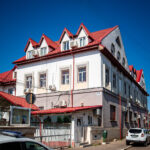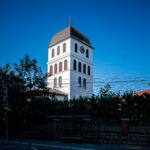
Municipal Police Headquarters
August 30, 2024
The Bell Tower and the Bookstore of the Archbishop of Buzău and Vrancea
August 30, 2024English
"ST. GEORGE" CEMETERY
After the Second Balkan War (1913), although they did not take part in decisive military actions, many soldiers from Buzău died due to the cholera epidemic. Some of them were buried in Buzău in the "Saint George" Cemetery (mentioned, in 1881, as "Saint Neculai"), located on the eastern edge of the city, near the Brăila barrier. In the spring of 1914, the officers and band of the 8th Buzău Regiment took the initiative to erect a monument in memory of their comrades who died in this war. This monument, actually a large stone cross, beautifully ornamented, on a plinth, was erected by public subscription, with the citizens of the city and county of Buzău participating enthusiastically in this financial effort.
During the First World War, the German army buried its dead soldiers here, in whose memory it also erected two monuments. All these monuments from the "ST. GEORGE" Cemetery were moved, in 1930, to the four corners of the Heroes' Cemetery in the courtyard of the Heroes' Church, located on Calea Eroilor Street in Buzău.
The "ST. GEORGE" cemetery in Buzău is also famous for the fact that, every year, Easter of the dead is celebrated here, a popular holiday related to the Resurrection of our Savior Jesus Christ. Thus, on the Monday after St. Thomas' Sunday, one week after the Resurrection of our Lord (Orthodox Easter), when the Roma community commemorates their dead, for whom they raise prayers and distribute red eggs and cozonac (a traditional holiday cake), as well as other offerings, the cemetery becomes a real celebration.




